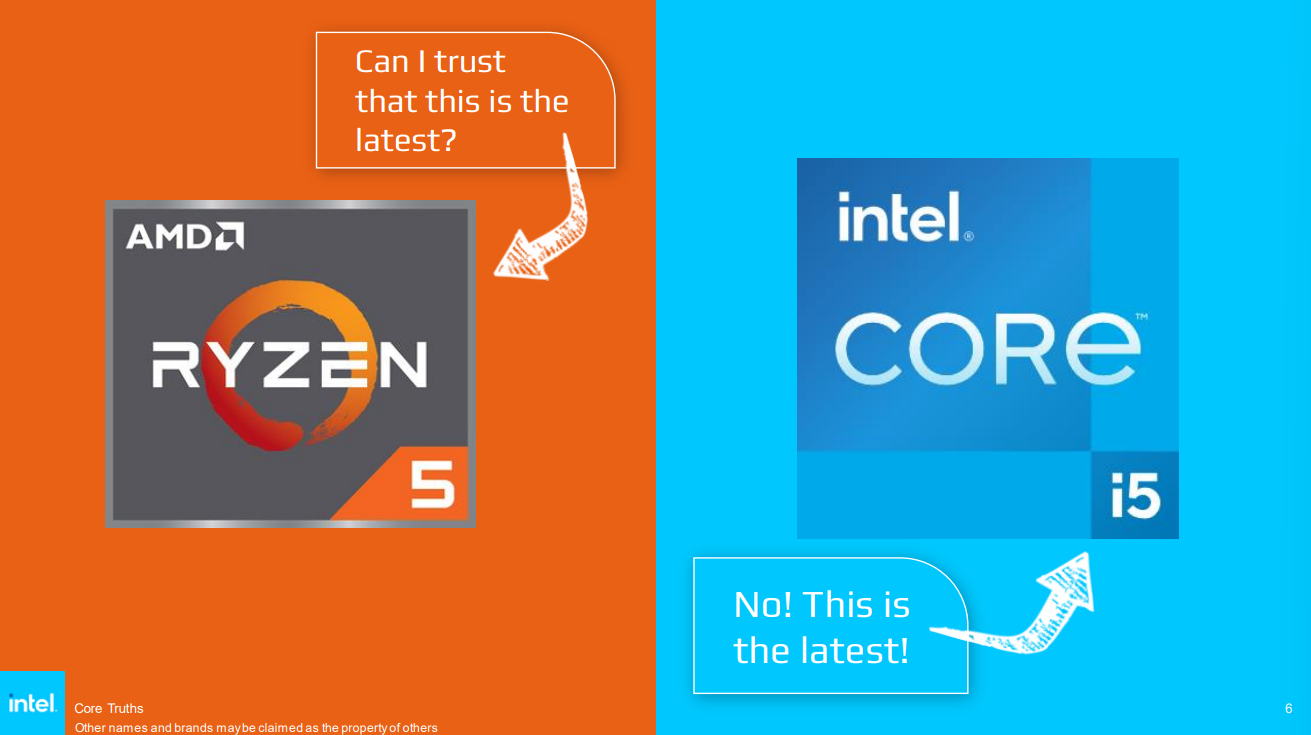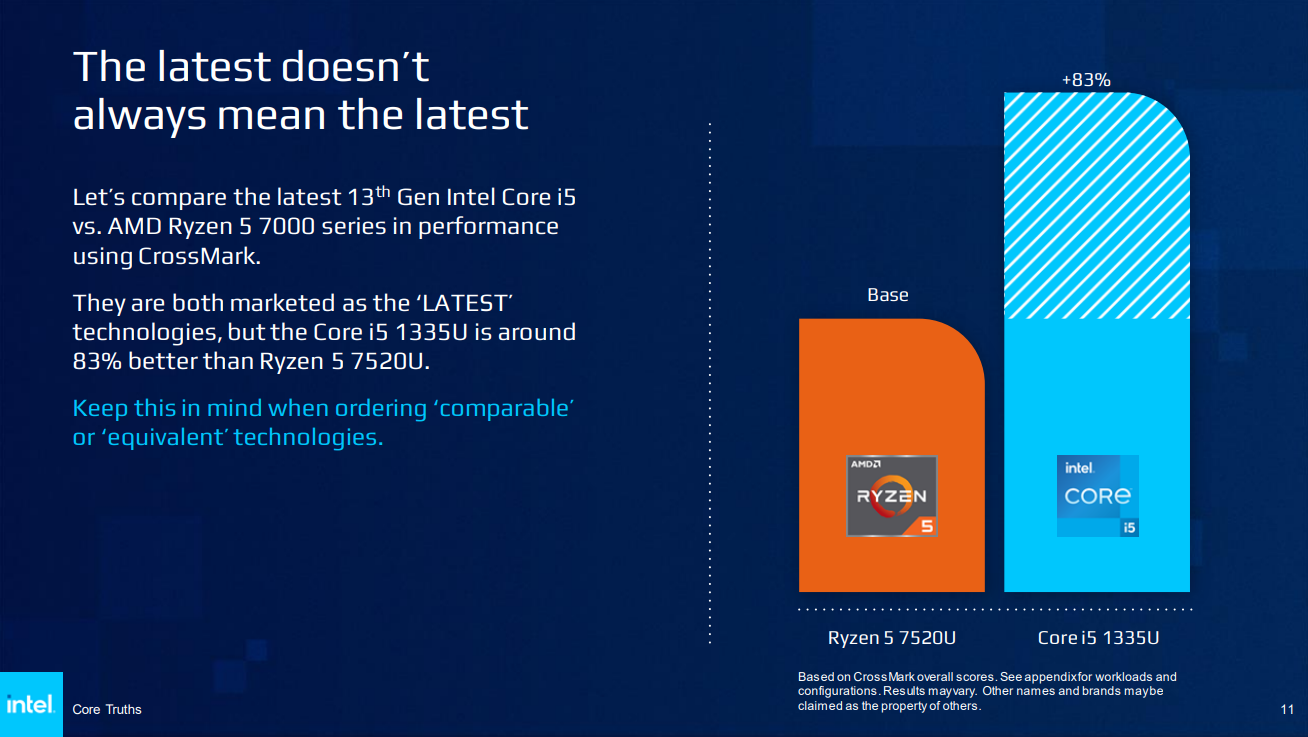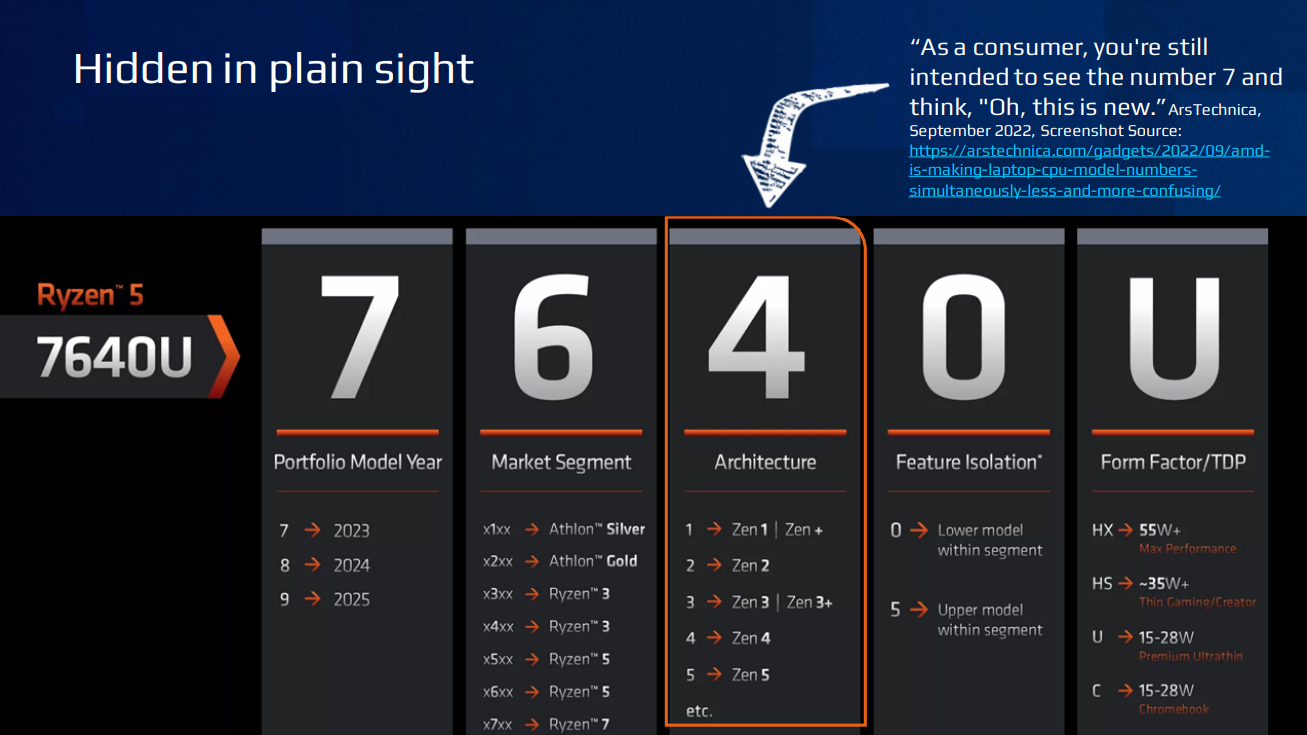Intel calls AMD's chips 'Snake Oil' for putting antiquated Zen 2 architecture in modern Ryzen 7000 mobile CPUs, but Intel also uses similar marketing tactics
Look in the mirror Intel

Intel recently published a new playbook titled "Core Truths" that put AMD under direct fire for utilizing its older Zen 2 CPU architecture in its latest Ryzen 7000 mobile series CPU product stack. Intel later removed the document, but we have the slides below. The playbook is designed to educate customers about AMD's product stack and even calls it "snake oil."
Intel's playbook specifically talks about AMD's latest Ryzen 5 7520U, criticizing the fact it features AMD's Zen 2 architecture from 2019 even though it sports a Ryzen 7000 series model name. Further on in the playbook, the company accuses AMD of selling "half-truths" to unsuspecting customers, stressing that the future of younger kid's education needs the best CPU performance from the latest and greatest CPU technologies made today. To make its point clear, Intel used images in its playbook referencing "snake oil" and images of used car salesmen.
The playbook also criticizes AMD's new naming scheme for its Ryzen 7000 series mobile products, quoting ArsTechnica: "As a consumer, you're still intended to see the number 7 and think, 'Oh, this is new.'" Intel also published CPU benchmark comparisons of the 7520U against its 13th Gen Core i5-1335U to back up its points. Unsurprisingly, the 1335U was substantially faster than the Zen 2 counterpart.





Some of the statements in Intel's playbook do have some merit. AMD's nomenclature for its Ryzen 7000 mobile parts can be confusing for novice consumers who haven't done their research. For reference, the number two in the Ryzen 5 7520U's product name states that the CPU comes with AMD's Zen 2 CPU architecture. If the chip had a newer architecture like Zen 3/Zen 3+, it would feature the number three; if it had Zen 4, it would have the number four, etc.
However, Intel's playbook unsurprisingly doesn't mention that it also uses similar strategies in its CPUs. In its 13th Gen Raptor Lake CPU lineup, Intel re-used its older 12th Gen Alder Lake CPU dies on its 13th Gen Core i3 and lower-end 13th Gen Core i5 models, effectively making them re-branded Alder Lake chips. This technique is one way CPU manufacturers maximize production efficiency.
In many ways, Intel is also doing this with all of its latest 14th-gen chips, featuring the Raptor Lake Refresh architecture. Despite the marketing increase in generational nomenclature, Intel's Raptor Lake Refresh architecture doesn't have any noteworthy IPC improvements to speak of over its Raptor Lake predecessor (found in 13th Gen chips). The only difference between the two is a minor fabrication change to a newer revision of the 'Intel 7' process node that enables slightly greater frequency headroom.
So, from a functionality standpoint, Intel's Raptor Lake Refresh chips are basically re-branded Raptor Lake chips, with the only difference being slightly higher core clocks on some models (except for the Core i7 variant). This makes them perform the same as their previous-gen counterparts (as our reviews have shown) despite having a brand-new nomenclature.
Get Tom's Hardware's best news and in-depth reviews, straight to your inbox.
All in all, Intel's new playbook is highly hypocritical. It downplays AMD's decision to re-use its older CPU architectures in its latest Ryzen 7000 products, even though Intel does the same thing in its own product stack.

Aaron Klotz is a contributing writer for Tom’s Hardware, covering news related to computer hardware such as CPUs, and graphics cards.
-
cknobman If you can't beat them...... talk * about them :ROFLMAO:Reply
Intel mostly makes power hungry garbage these days.
Seeing an Intel sticker on a laptop is actually a disincentive to buy IMO. -
usertests Isn't the i3-14100 just Alder Lake refreshed twice?Reply
And let's not forget the chip that's positioned against the Ryzen 5 7520U: the Core i3-N305, which somehow broke away from Intel Processor N200 and friends. -
btmedic04 Let's not forget the 5 generations of skylake. TopkekReply
Funnily enough, Robert Hallock was amds head of technical marketing and had a role to play in the decision of the naming convention used. Guess who is now intels senior director of marketing? -
-Fran- This is funny, because this screams "I bazooka'ed my foot".Reply
Intel, you do realize when you scritinize your rival, you will also be scrutinized as a consequence, right? At this point, they should have some semblance they're not the oppresive monster they were a few years back to whom almost no one wants to talk back to.
Man, I have my popcorn ready for this one. And right before Xmas no less! The marketing team at Intel's CPU division is in for a very extreme ride XD
Regards. -
HaninTH Reply-Fran- said:This is funny, because this screams "I bazooka'ed my foot".
Intel, you do realize when you scritinize your rival, you will also be scrutinized as a consequence, right? At this point, they should have some semblance they're not the oppresive monster they were a few years back to whom almost no one wants to talk back to.
Man, I have my popcorn ready for this one. And right before Xmas no less! The marketing team at Intel's CPU division is in for a very extreme ride XD
Regards.
The consumers can only hope this high school musical delivers us value. A new crop of CPUs to slap Intel around would be lovely, and the consequential price drops will be highly welcomed.
We can only hope that ARM's progression continues and the eventual inclusion of a 3rd player into the market will really shake things up, as long as Intel doesn't somehow, lock everyone down with contractual obligations again. -
syadnom I would argue that intel is so much worse than this because they've msqueraded atom chips as 'first class' laptop and desktop chips for years now. Labeling atoms at pentiums etc. These $299 laptops from best buy and walmart that have 2005 era performance are perfect examples. Worse, they have started putting 'i' labels on atom series chips more recently. Ultimate in deceptive marketing.Reply -
abufrejoval Didn't Intel also complain about Zen being cut & paste designs with IODs and CCDs glued in a "haphazard" manner?Reply
AMD is obviously in a quandary, because quite a lot of their cost efficiency rides on making do with the least number of actual chips and being able to cover the largest possible range of products with them.
And that leaves a lot of niches, where Intel with evidently no constraints on producing very permutation of IP blocks as a sellable product, can score a win.
If it's all about rebadging already produced chips into "new" products, that's perhaps not ideal, but given that not everyone actually needs a top performer, it's still better than putting them into a landfill.
If it's about being able to produce SKUs to match Intel's portfolio, I'm less of a fan: I just dislike intentionally crippled hardware just to plaster every possible price point imaginable. Zen 4c instead of Zen 4, I understand. Zen 3 where a Zen 4c design would have done the job, that probably could be justified with TMS fab utilization: if their 7nm (or 6nm) lines are running dry, I understand why AMD is jumping on the opportunity. Perhaps Tom's hardware could try to find out and score some points on being a real explainer?
The most important motto to follow is evidently "caveat emptor" and hopefully Tom's hardware and friends will continue to put the finger right where it needs to be, so at least the "savant emptor" won't get tripped into buying junk. -
helper800 Pot calling the kettle black in the most ironic way possible considering 14nm+++++++++++++.Reply